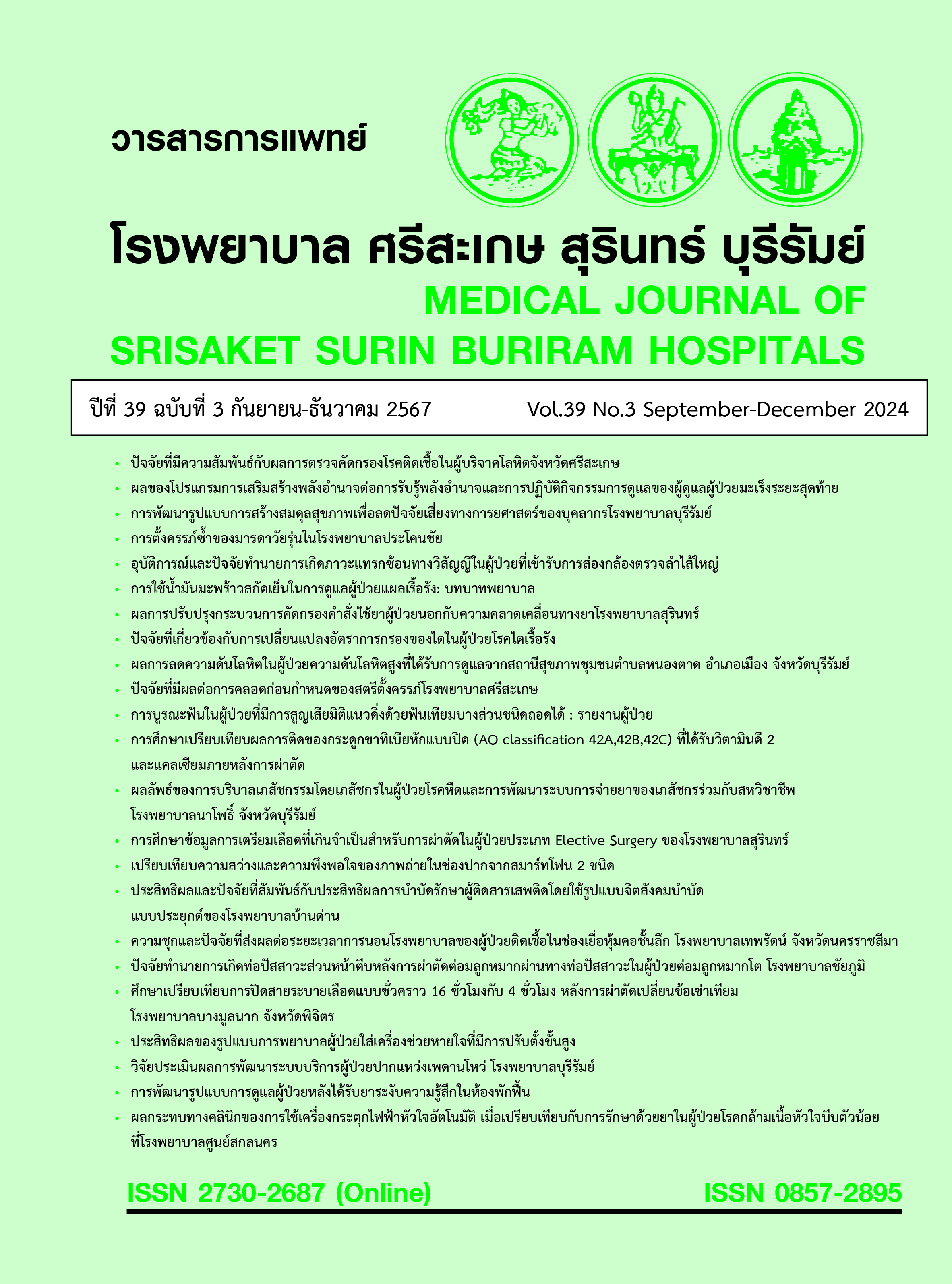The Evaluation of Service Development for Cleft Lip and Palate Patients at Buri Ram Hospital
Main Article Content
Abstract
Background: Cleft lip and palate are common congenital defects of the oral and maxillofacial that requires complex, multidisciplinary, and long-term management. This study aims to investigate the challenges in caring for patients with CLP and to evaluate the development of the CLP patient care system at Buri Ram Hospital, Thailand. The evaluation was conducted using the CIPP (Context, Input, Process, Product) Model, a comprehensive framework for program evaluation.
Methods: This study is evaluation research that collected data through questionnaires and focus group discussions. The sample consisted of 92 parents of children with cleft lip and palate who brought their children for treatment at Buri Ram Hospital, and 13 staff members and healthcare professionals from Buri Ram Hospital. Data were collected between January 2 and March 31, 2024. Quantitative data were analyzed using descriptive statistics, including percentages, means, and standard deviations. Qualitative data from focus group discussions were analyzed using content analysis.
Results: The study found: 1) Context: The implementation aligned with the department and hospital's goals. The plans and projects showed high potential for addressing health issues. However, there was a lack of budgetary planning for service development. The location for activities was suitable, but there were insufficient waiting seats. 2) Input: The hospital had a policy to partially assist with treatment costs beyond dental care rights. There was collaborative work and diverse services including tooth brushing training, pediatric dentistry, orthodontics, referrals, and participation from provincial Red Cross staff. Regular meetings were held with appropriate timing, but there was a lack of data collection for individual health promotion, child nutrition promotion, and psychological support from medical teams for some children. 3) Process: The project goals were achieved at a high level, but inter-departmental communication was lacking. 4) Output: The operation achieved its objectives. Staff participation led to high satisfaction and pride in their work. Service recipients reported high satisfaction (mean 4.1, standard deviation 0.4), with a satisfaction percentage of 80.9%. Barriers to accessing services included difficulty in traveling for continued care, and nearby healthcare facilities' inability to provide adequate information and treatment for children with cleft lip and palate.
Conclusion: This evaluation highlights ongoing challenges in service access, including budget planning, data collection for individual health promotion, child nutrition promotion, coordination with medical teams for mental health care, and the development of a dental patient referral system to ensure appropriate care from nearby healthcare facilities.
Article Details

This work is licensed under a Creative Commons Attribution-NonCommercial-NoDerivatives 4.0 International License.
References
Mossey PA, Shaw WC, Munger RG, Murray JC, Murthy J, Little J. Global oral health inequalities: challenges in the prevention and management of orofacial clefts and potential solutions. Adv Dent Res. 2011;23(2):247-58. doi: 10.1177/0022034511402083.
Mossey PA, Catilla EE. Global registry and database on craniofacial anomalies: Report of a WHO Registry Meeting on Craniofacial Anomalies. Geneva: World Health Organization; 2003.
Chowchuen B, Thanaviratananich S, Chichareon V, Kamolnate A, Uewichitrapochana C, Godfrey K. A multisite study of oral clefts and associated abnormalities in Thailand: The epidemiologic data. Plast Reconstr Surg Glob Open. 2016;3(12):e583. doi: 10.1097/GOX.0000000000000570.
ธิดา รัตนวิไลศักดิ์, พรพุทธิ ภัทรวุฒิพร. การประเมินภาพถ่ายรังสีกะโหลกศีรษะด้านข้างในผู้ป่วยเด็กกลุ่ม อายุ 6-12 ปี ที่ได้รับการรักษาภาวะปากแหว่งเพดานโหว่ข้างเดียว. วารสารการแพทย์โรงพยาบาลศรีสะเกษ สุรินทร์ บุรีรัมย์. 2565;37(3):719-27.
Chopra A, Lakhanpal M, Rao NC, Gupta N, Vashisth S. Oral health in 4-6 years children with cleft lip/palate: a case control study. N Am J Med Sci. 2014;6(6):266-9. doi: 10.4103/1947-2714.134371.
Vyas T, Gupta P, Kumar S, Gupta R, Gupta T, Singh HP. Cleft of lip and palate: A review. J Family Med Prim Care. 2020;9(6):2621-5. doi: 10.4103/jfmpc.jfmpc_472_20.
Stufflebeam DL, Coryn CL. Evaluation theory, models, and applications. 2nd ed. San Francisco, CA: John Wiley & Sons; 2014.
ธวัชชัย ปินเครือ. การประเมินผลโครงการต้นแบบตำบลฟันดีตำบลแม่พริก อำเภอแม่พริก จังหวัดลำปาง. วารสารวิชาการสาธารณสุขชุมชน. 2563;6(2):83-97.
วรางคนา เวชวิธี, สุรัตน์ มงคลชัยอรัญ. การประเมินผลแผนงานทันตสุขภาพสำหรับผู้สูงอายุ ประเทศไทยระยะที่ 1 (พ.ศ.2558-2561). การส่งเสริมสุขภาพและอนามัยสิ่งแวดล้อม. 2565;45(2):76-88.
Wayne WD, Cross CL. Biostatistic: A Foundation of Analysis in the Health Sciences. 6th ed. New Jersey: John Wiley & Sons, Inc.; 1995:117-8.
เพ็ญแข ลาภยิ่ง. คู่มือการดำเนินงานการดูแลเด็กปากแหว่งเพดานโหว่แบบองค์รวมไร้รอยต่อ. กรุงเทพมหานคร: โรงพิมพ์องค์การสงเคราะห์ทหารผ่านศึกในพระบรมราชูปถัมภ์; 2564.
ยุพิน ปักกะสังข์, สุธีรา ประดับวงษ์, ชิโนรส ปิยกุลมาลา, อารยา ภิเศก. ปัญหาการเข้ารับบริการของผู้ป่วยปากแหว่งเพดานโหว่. ศรีนครินทร์เวชสาร. 2565;37(4):331-6.
Allaf H, Helal N, Basri O, AlShadwi A, Sabbagh H. Care barriers for patients with nonsyndromic orofacial clefts in Saudi Arabia: A cross-sectional study. Cleft Palate Craniofac J. [in press].
Nidey NL, Wehby GL. Barriers to health care for children with orofacial clefts: a systematic literature review and recommendations for research priorities. Oral Health Dent Stud. 2019;2(1):1-12. doi: 10.31532/OralHealthDentStud.2.1.002.

